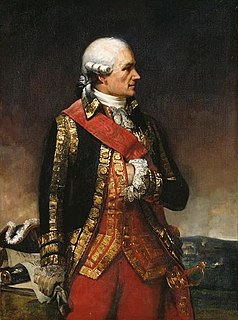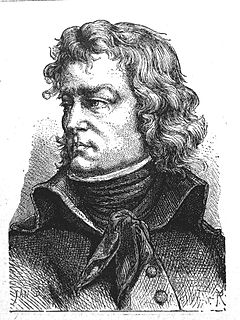
Adam Philippe, Comte de Custine was a French general. As a young officer in the Bourbon Royal army, he served in the Seven Years' War. In the American Revolutionary War he joined Rochambeau's Expédition Particulière supporting the American colonists. Following the successful Virginia campaign and the Battle of Yorktown, he returned to France and rejoined his unit in the Royal Army.

The Army of the North or Armée du Nord is a name given to several historical units of the French Army. The first was one of the French Revolutionary Armies that fought with distinction against the First Coalition from 1792 to 1795. Others existed during the Peninsular War, the Hundred Days and the Franco-Prussian War.

The French Revolutionary Army was the French force that fought the French Revolutionary Wars from 1792 to 1802. These armies were characterised by their revolutionary fervour, their poor equipment and their great numbers. Although they experienced early disastrous defeats, the revolutionary armies successfully expelled foreign forces from French soil and then overran many neighboring countries, establishing client republics. Leading generals included Jourdan, Bonaparte, Masséna and Moreau.

A demi-brigade is a military formation used by the French Army since the French Revolutionary Wars. The Demi-brigade amalgamated the various infantry organizations of the French Revolutionary infantry into a single unit. Each one was headed by a chef de brigade.

Jean Baptiste Camille de Canclaux was a French army commander during the French Revolution and a Peer of France. He joined a cavalry regiment the French Royal Army in 1756 and fought at Minden in the Seven Years' War. He attained the rank of maréchal de camp in 1788 and lieutenant general in 1792. He commanded the Army of the Coasts of Brest from May until October 1793 fighting several actions during the War in the Vendée. Replaced for political reasons, he led the Army of the West in 1794–1795. He held interior posts during the rest of the French Revolutionary Wars and under the First French Empire of Napoleon.
The Army of the Moselle was a French Revolutionary Army from 1791 through 1795. It was first known as the Army of the Centre and it fought at Valmy. In October 1792 it was renamed and subsequently fought at Trier, First Arlon, Biesingen, Kaiserslautern, Froeschwiller and Second Wissembourg. In the spring of 1794 the left wing was detached and fought at Second Arlon, Lambusart and Fleurus before being absorbed by the Army of Sambre-et-Meuse. In late 1794, the army captured Trier and initiated the Siege of Luxembourg. During the siege, the army was discontinued and its divisions were assigned to other armies.

The Army of the Ardennes was a French Revolutionary Army formed on the first of October 1792 by splitting off the right wing of the Army of the North, commanded from July to August that year by La Fayette. From July to September 1792 General Dumouriez also misused the name Army of the Ardennes for the right wing of what was left of the Army of the North after the split, encamped at Sedan and the name of Army of the North for the left flank of the army.

Antoine Morlot was a French division commander during the French Revolutionary Wars and Napoleonic Wars. After almost eight years of service in the French Royal Army, he became an officer in a local volunteer battalion during the French Revolution. In 1792 he fought with distinction at Thionville and other actions, earning a promotion to general officer in 1793. He was notable for his participation at the Battle of Kaiserslautern where he led a brigade. After another promotion he became a general of division in the Army of the Moselle. In 1794 he led his troops at Arlon, Lambusart, Fleurus and Aldenhoven.
Edward Butler was an officer in the United States Army who served as acting Adjutant General and acting Inspector General of the U.S. Army from 1793 to 1794 and from 1796 to 1797.
The 102nd Infantry Regiment was an infantry regiment of the French Revolutionary Wars and the Napoleonic Wars.

The Battle of Saorgio was fought from 24 to 28 April 1794 between a French First Republic army commanded by Pierre Jadart Dumerbion and the armies of the Kingdom of Sardinia-Piedmont and the Habsburg Monarchy led by Joseph Nikolaus De Vins. It was part of a successful French offensive designed to capture strategic positions in the Maritime Alps and Ligurian Alps, and on the Mediterranean coast. Tactical control of the battle was exercised by André Masséna for the French and Michelangelo Alessandro Colli-Marchi for the Coalition. Saorge is located in France, about 70 kilometres (43 mi) northeast of Nice. At the time of the battle, the town was named Saorgio and belonged to Piedmont.
Jean-Baptiste Meynier, born 22 April 1749 – died 3 December 1813, was a French soldier who served during the American Revolutionary War, the French Revolutionary Wars, and the Napoleonic Wars. Between 1792 and 1793, he rose from a captain to a general of division. During the Montenotte Campaign in 1796, he commanded a division under Napoleon Bonaparte, who had a low opinion of his military talent. In 1803 he was appointed to command the fortress of Mainz. He died there in 1813.
Juan de Courten (elder) or Juan Antonio Curten Massenet or Juan Courten or Juan Curten began his Spanish military career in the War of the Austrian Succession at the age of 14. His father was a brigadier general of engineers who died in 1745. Courten fought in the Spanish–Portuguese War (1761–1763), the Invasion of Algiers in 1775, and the Great Siege of Gibraltar. He was the last Spanish governor of Oran in 1792. As a lieutenant general, he led an infantry division during the War of the Pyrenees against the First French Republic in several actions including Perpignan, Peyrestortes, Truillas, Boulou, and the Black Mountain. He was appointed Captain General of Aragon in 1795.
Antoine Balland commanded a French infantry division during the early years of the French Revolutionary Wars. A former private, he was promoted to command an infantry regiment after the Battle of Jemappes. He became a general of brigade in late August 1793 and a general of division less than three weeks later. Soon afterwards, he led a division in Jean-Baptiste Jourdan's victory at Wattignies. In the spring of 1794, he led his troops at Le Cateau, Beaumont and Landrecies. By this time it was obvious that he did not have the talent to command a combat division and he was replaced by Jean Baptiste Kléber. He was not employed after June 1795 and died at Guise in 1821.
Maurice Frimont, born 14 December 1747 in Gondreville (Meurthe-et-Moselle), youngest child of Dominique Frimont, a laborer at Gondreville, and Catherine Laurent, was a general of the French Revolutionary Wars and, later Napoleonic Wars.
Jean-Marie Forest, 4 February 1752 Lyon – 12 June 1794 Modena was a general of the French Revolution.
Paul-Alexis Dubois commanded French divisions during the War of the First Coalition and was killed in action fighting against Habsburg Austria. He enlisted in a French infantry regiment in 1770 and transferred into the cavalry in 1776. Thereafter he served in several different cavalry and infantry regiments. From sous-lieutenant in 1791, he served in the Army of the Moselle and was rapidly promoted to general of brigade by August 1793. After briefly commanding an infantry division in the Army of the Rhine at Wissembourg he switched back to the Army of the Moselle to fight at Kaiserslautern before being wounded at Froeschwiller in December 1793.
Pierre Raphaël Paillot de Beauregard led a French division at the Battle of Wattignies. A nobleman, he joined the French Royal Army as a cadet in 1755 and fought in the Seven Years' War. He became a lieutenant colonel in 1779, but two years later got into a dispute with a superior officer and was placed on inactive service. The French Revolution and the War of the First Coalition saved his career; he was promoted general of brigade in 1792. He led a 2,000-man column at Arlon in 1793 but irritated his army commander. After his 5,800-strong division performed poorly at Wattignies he was put in prison for 10 months. He was briefly employed again during the War in the Vendée in 1795 before retiring from military service in 1796.
The 99th Infantry Regiment was an infantry regiment of the French Army. It was formed in 1791 by renaming the Royal Deux-Ponts Regiment and fought in the French Revolutionary Wars before being merged into another unit in 1803. A new and unrelated 99th Infantry Regiment was formed in 1855 and took on the traditions of the previous regiment.











